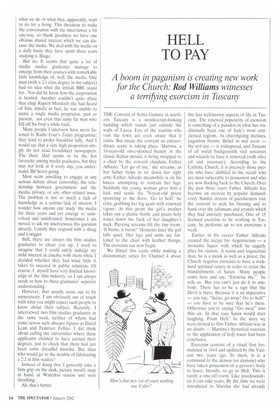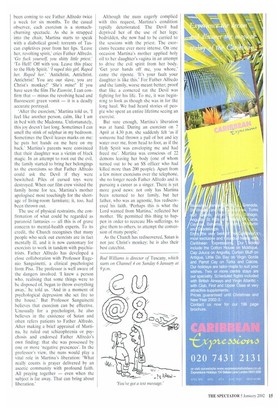HELL TO PAY
A boom in paganism is creating new work
for the Church: Rod Williams witnesses
a terrifying exorcism in Tuscany
THE Convent of Santa Gemma in northern Tuscany is a nondescript-looking building which stands just outside the walls of Lucca. Few of the tourists who visit the town are even aware that it exists. But inside the convent an extraordinary scene is taking place. Martina, a 16-year-old olive-skinned beauty in the classic Italian mould, is being strapped to a chair by the convent chaplain, Father Alfredo. 'Let go of me,' she screams, as her father helps to tie down her right arm; Father Alfredo meanwhile is on his knees, attempting to restrain her legs. Suddenly the young woman gives him a kick and sends the 76-year-old priest sprawling to the floor. 'Go to hell!' he cries, grabbing her leg again with renewed vigour. At this point the girl's mother takes out a plastic bottle and pours holy water down the back of her daughter's neck. Piercing screams fill the tiny room. 'It burns, it burns!' Moments later the girl falls quiet. Her legs and arms are fastened to the chair with leather thongs. The exorcism can now begin.
We filmed this scene while making a documentary series for Channel 4 about
the less well-known aspects of life in Tuscany. The renewed popularity of exorcism is something of a paradox in what has traditionally been one of Italy's most anticlerical regions. As churchgoing declines, paganism booms. Belief in rnal occio — the evil eye — is widespread, and Tuscans of all social backgrounds visit sorcerers and wizards to have it removed (with olive oil and rosemary). According to the Catholic Church, it is precisely those people who have dabbled in the occult who are most vulnerable to possession and who are now flocking back to the Church. Over the past three years Father Alfredo has become an exorcist by popular demand; every Sunday dozens of parishioners visit the convent to seek his blessing and to hand over the talismans and crystals which they had unwisely purchased. One of 15 licensed exorcists to be working in Tuscany, he performs up to ten exorcisms a week.
Earlier in his career Father Alfredo created the recipe for Argentarium — a monastic liquor with which he eagerly plies his visitors. A warm and loquacious man, he is a monk as well as a priest; the Church requires exorcists to have a rockhard spiritual centre in order to resist the blandishments of Satan. 'Many people come here and say, "Exorcise me,— he tells us. 'But you can't just do it to anybody. There has to be a sign that the Devil is there. Because it is an imperative
— you say, "Satan, go away! Go to hell!"
— you have to be sure that he's there. Otherwise you're saying "Go away" into thin air. In that case Satan would start laughing. From Hell.' In the story we were invited to film Father Alfredo was in no doubt — Martina's hysterical reaction to the application of holy water had been conclusive.
Exorcism consists of a ritual first formulated in 1614 and updated by the Vatican two years ago. In short, it is a command to the demon (or demons) who have taken possession of a person's body to leave: literally, to go to Hell. This is rarely a one-off event. Like psychoanalysis it can take years. By the time we were introduced to Martina she had already been coming to see Father Alfredo twice a week for six months. To the casual observer, each exorcism is a stomach churning spectacle. As she is strapped into the chair, Martina starts to speak
with a diabolical growl: torrents of Tuscan expletives pour from her lips. 'Leave her, revolting spirit,' cries Father Alfredo. 'Go fuck yourself, you shitty: little priest.' To Hell! Off with you. Leave this place to the Holy Spirit./ raped this girl. Raped her. Raped her."Antichrist, Antichrist, Antichrist! You are our slave, you are Christ's monkey!' 'She's mine!' If you have seen the film The Exorcist, I can confirm that — minus the revolving head and fluorescent green vomit — it is a deadly accurate portrayal.
'After the exorcism,' Martina told us, 'I feel like another person, calm, like I am in bed with the Madonna. Unfortunately, this joy doesn't last long. Sometimes I can smell the stink of sulphur in my bedroom. Sometimes the Devil leaves marks on me: he puts hot hands on me here on my back. Martina's parents were convinced that their daughter was a victim of black magic. In an attempt to root out the evil, the family started to bring her belongings to the exorcisms so that Father Alfredo could ask the Devil if they were bewitched. Piles of cursed toys were destroyed. When our film crew visited the family home for tea, Martina's mother apologised most touchingly for the shortage of living-room furniture; it, too, had been thrown out.
The use of physical restraints, the confirmation of what could be regarded as paranoid fantasies — all this is of grave concern to mental-health experts. To its credit, the Church recognises that many people who seek out exorcists are in fact mentally ill, and it is now customary for exorcists to work in tandem with psychiatrists. Father Alfredo has developed a close collaboration with Professor Eugenio Sanguinetti, a clinical psychologist from Pisa. The professor is well aware of the dangers involved. 'I knew a person who, realising that some things were to be disposed of, began to throw everything away,' he told us. 'And in a moment of psychological depression she set fire to the house.' But Professor Sanguinetti believes that exorcism can be effective. Unusually for a psychologist, he also believes in the existence of Satan and often refers patients to Father Alfredo. After making a brief appraisal of Martina, he ruled out schizophrenia or psychosis and endorsed Father Alfredo's own finding: that she was possessed by one or more 'negative presences'. In the professor's view, the nuns would play a vital role in Martina's liberation: 'What really counts is prayer delivered by an ascetic community with profound faith. All praying together — even when the subject is far away. That can bring about liberation.'
Although the nuns eagerly complied with this request, Martina's condition rapidly deteriorated. The Devil had deprived her of the use of her legs; bedridden, she now had to be carried to the sessions with the priest. The exorcisms became ever more intense. On one occasion Martina's mother applied holy oil to her daughter's vagina in an attempt to drive the evil spirit from her body. 'Get your hands off me, you whore,' came the riposte. 'It's your fault your daughter is like this.' For Father Alfredo and the family, worse meant better; proof that like a cornered rat the Devil was fighting for his life. To me, it was beginning to look as though she was in for the long haul. We had heard stories of people who spent an entire lifetime seeing an exorcist.
But sure enough, Martina's liberation was at hand. During an exorcism on 7 April at 4.30 p.m. she suddenly felt 'as if someone had thrown a pail of hot and icy water over me. from head to foot, as if the Holy Spirit was enveloping me and had freed me'. Martina was conscious of 22 demons leaving her body (one of whom turned out to be an SS officer who had killed more than 200 people). Apart from a few minor exorcisms over the telephone, she no longer needs Father Alfredo and is pursuing a career as a singer. There is yet more good news: not only has Martina been returned to her family, but her father, who was an agnostic, has rediscovered his faith. 'Perhaps this is what the Lord wanted from Martina.' reflected her mother. 'He permitted this thing to happen in order to recreate His sufferings, to give them to others, to attempt the conversion of many people.'
As the Church has rediscovered, Satan is not just Christ's monkey; he is also their best catechist.
Rod Williams is director of Tuscany, which starts on Channel 4 on Sunday 6 January at 9 p.m.























































 Previous page
Previous page